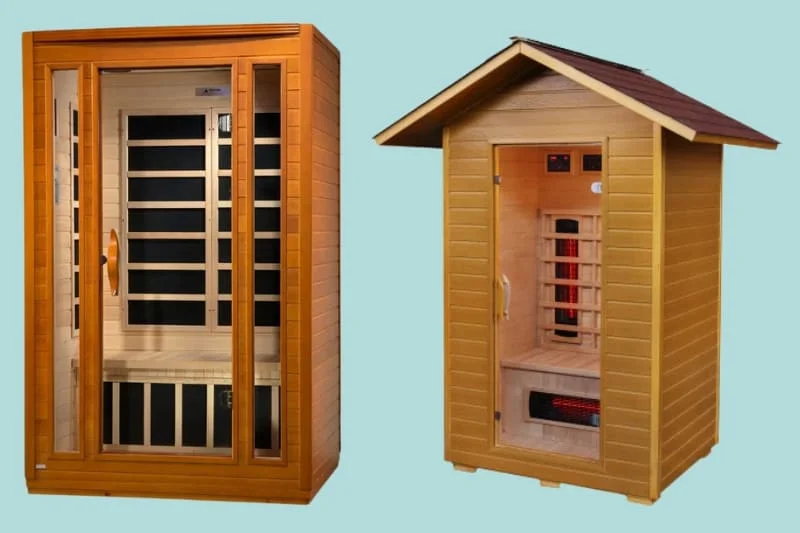Carbon Vs Ceramic Sauna Heaters: Which One Should You Buy?

Imagine stepping into your home sauna for a rejuvenating sweat session, only to be met with uneven heat and soaring energy bills. As an avid sauna user and enthusiast with years of experience exploring heating technologies, I’ve witnessed firsthand the pivotal role heaters play in enhancing or diminishing your sauna experience.
Not all infrared saunas are created equal? The heart of this distinction lies within their heating technology, with the two most prominent far infrared (FIR) heaters being carbon fiber and ceramic.
Key Takeaways
- Carbon heaters warm up in 10-15 minutes and use 0.2-0.4 kWh per hour , saving up to 80% on energy costs compared to ceramic models.
- Ceramic heaters reach temperatures up to 600°F (315°C) but can create uneven heat with cold spots.
- Carbon sauna heaters last 8-12+ years while ceramic ones typically last only 5-8 years due to thermal stress.
- Some manufacturers combine carbon and ceramic heaters in “hybrid” systems for balanced heating, though these cost 35% more than single-technology units.
- Carbon fiber dominates with 60% of the infrared sauna market due to energy efficiency and durability advantages.
Choosing between carbon and ceramic infrared heaters is more than just an aesthetic preference—it’s about performance, cost, and the quality of your health investment.
Dive deeper with me into the nuanced world of carbon vs ceramic sauna heaters as we uncover what sets them apart and also how they can complement each other in creating the perfect detox haven.
Ready to unravel the mystery? Let’s embark on this enlightening journey together.
Table of Contents
Overview of Carbon Sauna Heaters
Stepping away from the traditional into the modern world of sauna technology, let’s explore carbon sauna heaters, where cutting-edge design meets relaxation needs.
Carbon fiber panels emit far infrared rays with wavelengths of 4-14 microns, which penetrate 5-7 mm deep into your skin to soothe and invigorate your body at a molecular level.
These heaters have maximum sauna temperatures of 190°F (87.8°C), much lower than ceramic models, making them safer while still highly effective. The gentle warmth doesn’t create hot spots but instead surrounds you evenly.
Carbon heaters excel in:
- Energy efficiency: Using only 0.2-0.4 kWh per hour
- Quick startup: Reaching full heat in just 10-15 minutes
- Long lifespan: Lasting 8-12+ years with normal home use
- Uniform heating: Creating consistent temperatures throughout the sauna
The sturdy carbon fiber material resists degradation even after countless hours of use. Unlike ceramic heaters, there’s minimal risk of breakage, making them a smart choice for those who want a long-term sauna investment.
Overview of Ceramic Sauna Heaters
Ceramic sauna heaters are powerhouses of heat generation. They create substantial warmth due to their excellent thermal properties, reaching surface temperatures up to 600°F (315°C)—like having a concentrated campfire in your sauna space.
These traditional heaters produce shorter infrared wavelengths (2-5 microns) that penetrate about 3-4 mm into the skin. While not as deep as carbon fiber’s reach, this focused heat works well for targeted relief.
What sets ceramic heaters apart:
- Intense heat output: Creates powerful surface-level warmth
- Quick peak temperatures: Reaches maximum heat rapidly once warmed up
- Lower initial cost: About 15-20% less expensive than carbon fiber models
- Focused therapy: Excellent for targeting specific muscle groups
However, these benefits come with tradeoffs. Ceramic heaters require 20-30 minutes to warm up fully and consume significantly more energy—1.5-2 kWh per hour, more than triple the power needs of carbon heaters.
The high operating temperatures also put stress on the ceramic material, leading to a shorter average lifespan of 5-8 years and higher rates of cracking and breakdown.
Comparing Carbon vs Ceramic Sauna Heaters: Which One Should You Choose?
Let’s examine how these technologies stack up against each other across the factors that matter most to sauna users.
Energy Efficiency
The difference in energy consumption between these heater types is striking:
- Carbon heaters use just 0.2-0.4 kWh per hour, which means a typical 45-minute session costs about $0.045 (at average US electricity rates).
- Ceramic heaters consume 1.5-2 kWh per hour, making the same session cost around $0.34—over 7 times more expensive.
For regular sauna users, this adds up quickly. With four weekly sessions, monthly operating costs average $0.72 for carbon vs. $3.60 for ceramic systems.
Heat Distribution & Effectiveness
Heat quality matters as much as quantity when it comes to sauna therapy:
Carbon fiber heaters distribute heat across large panel surfaces, creating temperature variations of only ±2°C throughout the sauna. This gentle, even warmth allows for longer, more comfortable sessions.
Ceramic heaters create focal hotspots with temperature differences exceeding 15°C, meaning you might feel too hot in some spots and too cold in others. This uneven distribution can reduce the therapeutic benefits of your sauna session.
The infrared wavelength differences also affect how your body responds:
- Carbon’s 4-14 μm wavelengths match the body’s optimal absorption spectrum
- Ceramic’s 2-5 μm wavelengths work well for surface-level relief but don’t penetrate as deeply
Durability & Maintenance
Your sauna heater is a long-term investment that should provide years of reliable service:
Carbon fiber heaters have common failure points in electrical connectors (15% of failures) and frame warping (5%), but these issues develop slowly and are often repairable.
Ceramic heaters experience element cracking (25% of failures) and insulation breakdown (10%) due to the extreme temperature cycles they endure.
Maintenance requirements reflect this durability difference:
- Carbon systems need just annual inspections of electrical connections
- Ceramic models require bi-annual element testing and more frequent part replacements
This translates to warranties as well—carbon heaters typically come with 5-year coverage while ceramic models rarely exceed 2-3 years.
Health & Safety Considerations
Both heater types are generally safe, but some important differences exist:
EMF (Electromagnetic Field) Levels:
- Carbon fiber: 0.8-1.2 mG at 6″ distance
- Ceramic: 1.5-2.3 mG near emitter surfaces
Both fall below the 3mG threshold considered safe for regular exposure, but carbon’s lower EMF output may appeal to health-conscious users.
Risk Factors:
- Ceramic heaters have a higher thermal burn risk (3.2 incidents per 10,000 sessions)
- Carbon fiber systems have a small risk of orthostatic hypotension (1.8% of users) from prolonged vasodilation
Comprehensive Comparison Table
| Feature | Carbon Fiber Heaters | Ceramic Heaters |
|---|---|---|
| Surface Temperature | 190°F (87.8°C) | Up to 600°F (315°C) |
| Warm-up Time | 10-15 minutes | 20-30 minutes |
| Energy Usage | 0.2-0.4 kWh/hour | 1.5-2 kWh/hour |
| Wavelength Range | 4-14 microns (far infrared) | 2-5 microns (near/mid infrared) |
| Tissue Penetration | 5-7 mm | 3-4 mm |
| Heat Distribution | Even (±2°C variance) | Uneven (>15°C variance) |
| Average Lifespan | 8-12+ years | 5-8 years |
| EMF Levels | 0.8-1.2 mG | 1.5-2.3 mG |
| Price Range (2024) | $2,500-$8,000 | $1,500-$4,500 |
| 10-Year Cost | $6,320-$10,240 | $10,400-$17,200 |
| Market Share | 60% of infrared sauna market | 40% of infrared sauna market |
The Potential of Using Carbon and Ceramic Heaters Together
Some manufacturers have started combining both technologies in “hybrid” sauna systems. This approach aims to get the best of both worlds:
- Ceramic elements provide high initial heat to get your session started quickly
- Carbon panels maintain comfortable, even warmth for extended therapy
According to testing by Clearlight Saunas, hybrid systems can deliver the full therapeutic wavelength spectrum from 2-14 microns, addressing more health concerns than either technology alone.
However, hybrid systems come with tradeoffs:
- Higher cost: 35% price premium over single-technology units
- Greater complexity: 22% higher failure rate than simpler designs
- Mixed energy efficiency: 0.8 kWh per 45-minute session—better than ceramic but less efficient than pure carbon systems
Market Insights
The sauna market shows a clear direction in heating technology preferences.
According to some sauna industry analysts, Carbon fiber will capture 70% of the residential market by 2030 due to smart integrations and hybrid designs.
This shift is already happening, with carbon fiber currently holding 60% of the global far-infrared sauna market compared to ceramic’s 40% share in short/medium-infrared applications.
Conclusion
Choosing between carbon and ceramic sauna heaters comes down to what matters most for your sauna experience.
Carbon fiber heaters offer even heat distribution, deeper tissue penetration, and superior energy efficiency. Though more expensive upfront, their 8-12+ year lifespan and 75% lower operating costs make them the better long-term investment for most home users.
Ceramic heaters provide intense, focused heat at a lower initial price. Their higher operating temperatures work well for targeted therapy, but they consume significantly more energy and typically need replacement sooner.
The market trend is clear—carbon fiber now holds 60% market share and continues growing at 25% annually. For most sauna owners, the $4,000-$7,000 saved in energy and maintenance costs over ten years makes carbon heaters the smarter choice despite the higher purchase price.
Hybrid systems combining both technologies offer comprehensive benefits for those willing to pay the premium.
Do you own an infrared sauna? What’s your heater type? Please let me know in the comments below.
FAQs About Carbon vs Ceramic Sauna
What type of sauna is best for detox?
Carbon fiber infrared saunas are ideal for detox. Their optimal wavelengths and consistent low-temperature heat maximize toxin elimination through sweat. The longer sessions these saunas allow help your body remove more heavy metals and environmental toxins.
What type of sauna is best for inflammation?
Far infrared saunas with carbon fiber heaters work best for inflammation. Their deep-penetrating wavelengths reduce inflammatory markers while maintaining comfortable temperatures for longer sessions, maximizing anti-inflammatory effects.
What are the downsides of infrared saunas?
Infrared saunas have several downsides: high upfront costs, ongoing electricity expenses, occasional lightheadedness, and burn risks with ceramic models. They’re not suitable for pregnant women in their first trimester or people with electronic implants.
How often should you sauna?
Use saunas 3-4 times weekly for 20-45 minutes per session depending on experience. Beginners should start with 10-15 minutes at lower temperatures. People with health conditions should consult a doctor first. Always hydrate before and after sessions.

“Become a Sauna Expert Overnight!”
Grab Your “FREE” Sauna E-book NOW!
Get your hands on the ultimate sauna manual. From history to DIY setups, our free guide has it all.

As a Chartered Accountant turned sauna enthusiast, I bring a unique blend of analytical skills and hands-on experience to the world of heat therapy. With over a decade dedicated to researching and testing sauna products and practices, I’ve developed a deep understanding of this field. A the founder of HomeInDepth.com, I provide reliable, easy-to-understand information on all aspects of saunas. My goal is to guide you through every step of your sauna journey, offering meticulously researched, unbiased advice to help you make informed decisions and create your perfect sauna experience. Contact me on:







One Comment